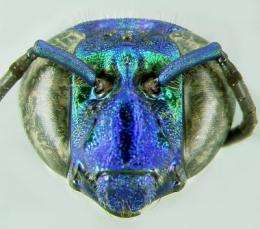First radio tracking of tropical orchid bees

Blue-green orchid bees zip through increasingly scarce patches of tropical forest pollinating rare flowers. For the first time, researchers at the Smithsonian Tropical Research Institute track unique signals from tiny transmitters glued to individual orchid bees, yielding new insight into the role of bees in tropical forest ecosystems.
"When people disturb and destroy tropical forest they disrupt pollination systems," said David Roubik, senior staff scientist at STRI. "Now we can track orchid bees to get at the distances and spatial patterns involved in pollination—vital details that have completely eluded us in the past."
The team trapped 17 iridescent orchid bees, Exaerete frontalis, which are fairly common in the forest. "These bees easily carry a 300-milligram radio transmitter glued onto their backs," said Martin Wikelski, director of the Max Planck Institute for Ornithology, professor at Princeton University and research associate at STRI. "By following the radio signals with a hand-held antenna, we discovered that male orchid bees spent most of their time in small core areas but could take off and visit areas farther away. One male even crossed over the shipping lanes in the Panama Canal, flew at least 5 kilometres, and returned a few days later."
People have struggled to determine the distances that bees travel by following individuals marked with paint between baits, or using radar, which does not work well when trees are in the way. "Carrying the transmitter may reduce the distance that the bees travel," said Roland Kays, curator of mammals at the New York State Museum and research associate at STRI. But even if the flight distances we record are the minimum distances that these orchid bees can fly, they are impressive, long-distance movements. "These data help to explain how orchids these bees pollinate can be so rare."
More information: Martin Wikelski, Jerry Moxley, Alexander Eaton-Mordas, Margarita M. López-Uribe, Richard Holland, David Moskowitz, David W. Roubik, Roland Kays. 2009. Large-range Movements of Neotropical Orchid Bees Observed via Radio Telemetry. dx.plos.org/10.1371/journal.pone.0010738
Provided by Smithsonian Tropical Research Institute



















